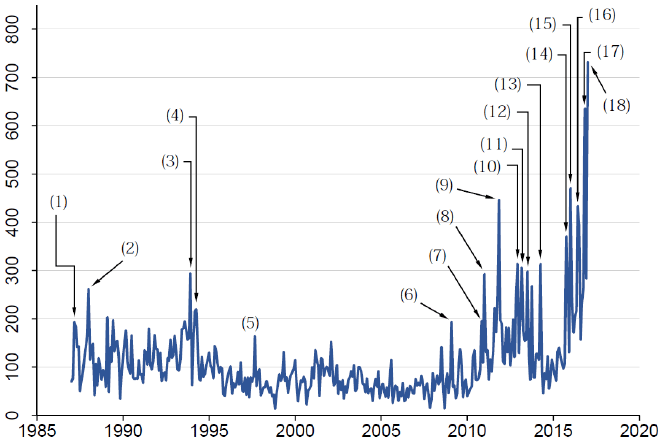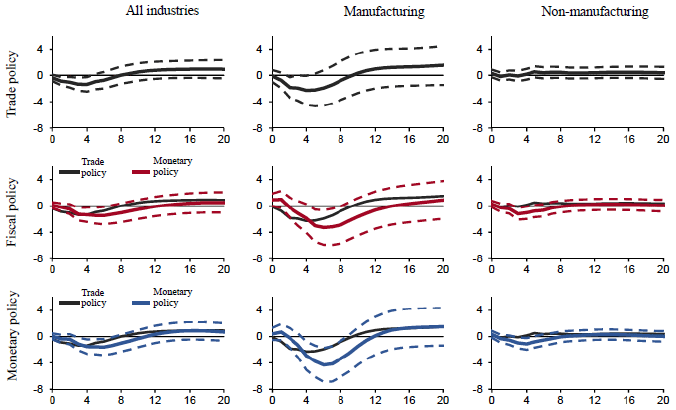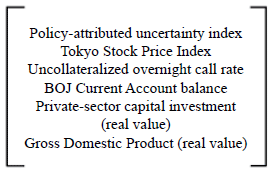Last year, the United Kingdom (UK) held a referendum on the nation's European Union (EU) membership, and voted to leave the EU. The UK and the EU will start negotiations this year on the terms of Brexit. Meanwhile, the United States has sworn in a new president for the first time in eight years. These events are leading to an increasingly unclear outlook for trade policies. This article examines this trend.
For about the last three months, the new U.S. government's policies have clouded the outlook of the world economy (Note 1). It is unclear which of the election pledges will be honored by the new U.S. president, and, if there is to be a change of government policies, when such a change will happen. There is also a great deal of uncertainty as to how the new administration's policies will affect the economy. Japanese business managers are paying keen attention to the new administration's policies, particularly those for fiscal and trade (Note 2).Corporate executives are also directing their attention to political situations in Europe. This year, Germany and France, two of the EU's key players, are holding federal parliamentary elections and presidential elections respectively. Both of these countries are seeing the anti-EU political parties becoming influential. The election results could destabilize their government administrations, creating an even greater sense of murkiness to the policy outlook.
With regard to trade policies, for example, Japan and the EU are in their final stage of negotiations in hammering out an economic partnership agreement (EPA). Even if the two sides reach a general agreement, the implementation of an EPA is a lengthy process, requiring ratification by the EU member states. Europe's political climate could affect the fate of the Japan-EU EPA, just like what has happened with the Trans-Pacific Partnership (TPP) Agreement. As such, the world outlook on trade policies is overshadowed with uncertainty. Business surveys suggest that this uncertainty over trade policies is affecting business management (Morikawa, 2016) (Note 3). Capital investment is the area of business decision-making that is the most strongly affected. What is the relationship between corporate capital investment and the lack of clarity in trade policies? Is the relationship different between manufacturers and non-manufacturing businesses? Is it different between trade policies and other policies, such as fiscal and financial? Such knowledge would be useful not only for economists but also for policy practitioners. In what follows, based on my recent research findings, I will show that while capital investment in manufacturing has a negative correlation with the lack of clarity over trade policies, there is no such correlation in non-manufacturing, and corporate capital investment has a stronger relationship with the murkiness of fiscal and monetary policies than with trade policies.How do we quantify the degree of policy uncertainty
Uncertainty attributable to government policies cannot be directly observed. One approach to deal with this issue is to measure proxy indicators that show such uncertainty indirectly.
A research project team consisting of University of Chicago Professor Steven J. Davis, Stanford University Professor Nick Bloom, and others developed an economic policy uncertainty index using articles published in major U.S. newspapers. Behind the approach of using newspaper articles, it is assumed that when household and companies are facing policy uncertainty, it is more likely that newspapers carry related articles.
I attempted a similar approach to develop an uncertainty index concerning trade policies. More specifically, articles containing terms associated with economic activities, terms associated with uncertainty, terms associated with policies in general, as well as terms associated with trade policies have been collected from morning and evening editions of the Asahi, Nikkei, Mainichi, and Yomiuri newspapers on a month-to-month basis since January 1987. Articles are searched on databases offered by newspaper publishers (Note 4).
The number of articles containing these terms in a particular month is then divided by the total number of articles carried in the applicable newspaper in that month to obtain ratio data. The data are then normalized so that the standard deviation for the period from January 1987 to December 2015 is set to one. The four series of numbers normalized for each month are added up to obtain time series data, which are then adjusted so that the average for the period from January 1987 to December 2015 is set to 100.
Uncertainty index concerning trade policies based on newspaper articles
Figure 1 shows monthly uncertainty index on trade policies based on newspaper articles. The data sampling period is from January 1987 to January 2017.

(1) The U.S. government led by President Ronald Reagan decides to impose a trade sanction on Japan (March 1987).
(2) The U.S. Congress deliberates on the draft bill on omnibus foreign trade (January 1988).
(3) Final negotiations take place to reach an agreement in the GATT Uruguay Round of trade talks (December 1993).
(4) The Super 301 provision of the 1988 Omnibus Foreign Trade and Competitiveness Act is revived (March 1994).
(5) Asian currency crisis
(6) The U.S. Congress deliberates on the American Recovery and Reinvestment Act, which includes the Buy American provision (February 2009).
(7) The ruling Democratic Party of Japan (DPJ) suffers in-fighting over participation in TPP negotiations. Prime Minister Naoto Kan announces that Japan will commence talks with relevant nations in preparation for entering into TPP negotiations (November 2010).
(8) In a Cabinet reshuffle, Prime Minister Kan appoints pro-TPP Banri Kaieda as the Minister of Economy, Trade and Industry (January 2011).
(9) The ruling DPJ suffers intense in-fighting over participation in TPP negotiations (November 2011).
(10) The anti-TPP Liberal Democratic Party wins general elections.
(11) Prime Minister Shinzo Abe announces Japan's participation in TPP negotiations (March 2013).
(12) Leaders from TPP-participating nations end a negotiation meeting without reaching a general agreement (October 2013).
(13) Japan-U.S. talks on the TPP hit a stumbling block over concerns that the bill on Trade Promotion Authority might not pass the U.S. Congress (April 2014).
(14) Final negotiations toward the TPP agreement take place amidst concerns about its ratification by countries such as Japan and the United States (October 2015).
(15) There are concerns about having the TPP agreement approved by the U.S. Congress while President Barack Obama is still in office. Japan's Economic Revitalization Minister Akira Amari resigns (January 2016).
(16) EU referendum takes place in the United Kingdom (June 2016).
(17) U.S. presidential election (2016)
(18) New U.S. President Donald Trump is sworn in (January 2017).
The graph shows that the index spiked three times. The first spike came in the early 1990s, coinciding with the final stage of the General Agreement on Trade and Tariffs (GATT) Uruguay round of trade talks in 1993. The second spike was in the early 2010s, around the time of intense confrontation within the ruling Democratic Party of Japan in November 2011 over Japan's participation in the TPP negotiations.
The third spike has been ongoing since 2016. In June 2016, the United Kingdom held a referendum on the nation's EU membership, and the majority voted to leave the EU. This caused uncertainty over negotiations on the terms of UK's exit from the EU. In November 2016, Republican Party candidate Donald Trump won the U.S. presidential election, intensifying uncertainty on the possibility of attaining U.S. Congress's approval for the TPP while President Barack Obama was still in office, and on the course of trade policies under the new administration. In January 2017, the index topped 700 points, which indicates that the degree of uncertainty is at the highest level in the last 30 years.
Relationship with corporate capital investment
The graphs in Figure 2 illustrate the dynamic response of capital investment to an increase in policy-attributed uncertainty. The graphs in the first row show the impulse response function (IRF) with a 40-point positive shock against a trade policy (Note 5). The horizontal axis represents the number of fiscal quarters elapsed from the time of the shock. Forty points represent the size equivalent to the difference between the 2009-2010 (start of TPP negotiations) average and the 2014-2015 (final stage of TPP negotiations) average.

Corporate capital investment decreases following a shock (Column 1), hitting the bottom (-1.4%) one year post-shock. This constitutes the main cause of the 0.4% reduction in gross domestic product (GDP). Capital investment in non-manufacturing sector hardly react to a shock, but the capital investment in manufacturing dips significantly (Columns 2 and 3).
The graphs in the second and third row show the IRF in response to a positive uncertainty shock concerning a fiscal policy and a monetary policy respectively. These graphs include the corresponding IRF curve for a trade policy as well to visually show differences between policy types. The size of a shock is set at the same scale as that concerning a trade policy. This makes it possible to directly compare the scale of response in capital investment.
Corporate capital investment decreases for a period of 1.5 years following a shock (Column 1). The response lasts slightly longer than that concerning a trade policy. In both the manufacturing and non-manufacturing sectors, corporate capital investment is more strongly affected by uncertainty over a fiscal policy/financial policy rather than a trade policy (Columns 2 and 3).
In summary, heightened uncertainty over trade policies would reduce corporate capital investment, thereby slowing down the nation's economic activities as a whole. As mentioned earlier, the level of uncertainty over trade policies has been building up significantly over the last three months. This must be monitored as a factor in an economic downturn.


